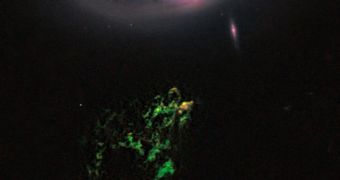Astronomers with the University of Alabama in Tuscaloosa say that they were recently able to collect new images of Hanny's Voorwerp (Object), using the NASA Hubble Space Telescope.
This particular structure, which looks like a massive blob of green gas floating through space, is one of the weirdest astronomers discovered in the entire Universe. It can be seen floating around a spiral galaxy, the group that observed it again said.
The Hubble photograph was showcased on January 10 at the winter meeting of the American Astronomical Society in Seattle (AAS 2011). UA expert William Keel conducted the team that carried out the new study.
While peering deep within this massive object, the renowned space telescope was able to identify a number of new things, such as for example pockets of young star clusters, gas filaments, and even a stellar nursery.
“The star clusters are localized, confined to an area that is over a few thousand light-years wide,” Keel said at the AAS 2011 conference. For comparison, the Milky Way is about 100,000 light-years wide.
“The region may have been churning out stars for several million years. They are so dim that they have previously been lost in the brilliant light of the surrounding gas,” he went on to say.
Although not discovering the stars within Hanny's Voorwerp might be seen a gross negligence on the part of astronomers that looked at the gas blob before, experts explain that doing so is not that easy.
The new stars that form within the stellar nursery are surrounded by very thick layers of hydrogen gas and cosmic dust, which block visible light wavelengths from passing through.
According to the Hubble photos, the stellar nursery inside the Object lies in the direction of the spiral galaxy IC 2497, which is located about 650 million light-years from the Sun. This means it lies relatively close, in astronomical terms.
The most interesting thing here is that the galaxy was discovered in past radio surveys to be losing a lot of hydrogen gas from its central regions. The Hubble image reveals that the escaped gas is interacting with an area in Hanny's Voorwerp, creating the new stellar nursery.
Stars have been under production there for a very short time, considering that most of the ones that have discovered thus far are only a few million years old.
Astronomers also determined that the reason the gas blob is so visible in the sky is because it was back-lit by emissions from a quasar, which occurred not too long ago, Space reports.
“We just missed catching the quasar, because it turned off no more than 200,000 years ago, so what we're seeing is the afterglow from the quasar,” Keel explained.
“This implies that it might flicker on and off, which is typical of quasars, but we've never seen such a dramatic change happen so rapidly,” he concluded.

 14 DAY TRIAL //
14 DAY TRIAL //